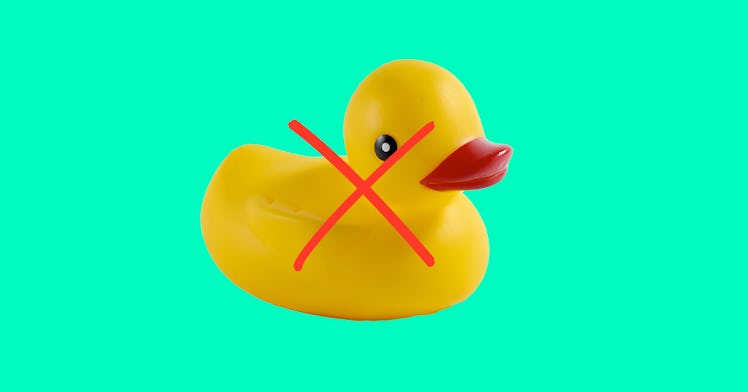The Toxic Truth About Plastic Toys For Kids
“One piece of advice I’d give to parents of young children—avoid plastic toys altogether.”

Metalworking runoff in Mickey Mouse slippers. Rubber duckies laced with flame retardants. Rubik’s Cubes leaking electronic waste. Chalk it up to weak regulation–the U.S. isn’t party to the Stockholm Convention, which handles this sort of thing–or corporate greed, but a whole lot of children’s toys are contaminated with industrial chemicals and the source is not mysterious at all. The proliferation of toxins like OctaBDE and DecaBDE (components of electronic waste), HBCD (found in building insulation), and SCCPs (metalworking chemicals) comes courtesy of the plastic recycling process. Today’s chewed-up toys are yesterday’s obsolete office equipment, which sounds good in principle, but may prove disastrous in practice.
“From a chemical manufacturing perspective it’s a cheap stream of plastics and, on the surface, recycling sounds like a good thing,” Pamela Miller, co-chair of the International Persistent Organic Pollutants Elimination Network, explains. “But if you have toxic chemicals in the recycling stream and you’re putting them in children’s products…. I don’t want parents to be alarmed unnecessarily, but I believe they have a right to know.”
Miller and others are sounding an alarm, going so far as to caution parents against purchasing plastic baby toys. That advice may sound extreme, but these are not benign chemicals. The Environmental Protection Agency describes OctaBDE and DecaBDE as “persistent, bioaccumulative, and toxic to both humans the environment.” One hundred and fifty two nations agreed to phase out HBCD in 2013, due to studies that suggested it affects thyroid function and brain development. And the International Agency for Research on Cancer considers SSCPs possibly carcinogenic, along with engine exhaust and welding fumes.
In 2015, IPEN tested a small sample of 21 children’s toys and found nearly half were contaminated with toxic flame retardants that originated from electronic waste. This January, researchers in Sweden reported that children’s toys were more likely than sex toys to contain banned chemicals. In April, IPEN released studies suggesting that 90 percent of children’s toys may contain either OctaBDE or DecaBDE, and that 67 percent may exceed Stockholm Convention hazardous waste limits for SCCPs. A study published last month found evidence of flame retardant chemicals in 61 percent of toys tested.
“In the vast majority of cases the plastic used to manufacture new toys is, at least in part, recycled,” Antonella Guzzonato of Birmingham University in the UK, and authors of the most recent flame retardant study, told Fatherly. “This means that if contaminated items unintentionally end up in the recycling mix, those contaminants will be found again in the new toy.” Countries that rely on cheap plastic exports lean heavily on recycled products. China, for instance, produced 3.2 billion tons of industrial solid waste in 2014. Two billion tons were subsequently recycled, which would be an environmental coup if chemicals weren’t being recycled into jump ropes.
Still, there aren’t very many robust studies on toddlers who have been exposed to these chemical contaminants and what little literature exists remains inconclusive. Industry advocates maintain (correctly) that most of the research that has shown that these chemicals impact brain development and reproductive health has been based on animal studies, which may not translate to humans. And in 1999 the UK Department for Trade and Industry released a report that concluded that such fears were unfounded in humans, and merely “chemical paranoia.”
But Miller isn’t taking any chances. “There’s no reason why these chemicals need to be in these products, in children’s toys,” she says. “And they are, in fact, quite harmful.”
Neither, apparently, is the international community. The European Union recently cracked down on recycled materials that contain OctaBDE and DecaBDE, and Guzzonato says this is a crucial step. “If all waste contamination is known and controlled,” she says. “No contaminants can end up in toys.”
The Stockholm Convention recently closed a loophole in that allowed manufacturers to recycle certain contaminants as long as they didn’t produce new ones. “It was a crucial achievement…that the exemption for recycling, which was called for by a few countries, was not granted,” Andreas Buser, scientific officer of the Industrial Chemicals Section for the Swiss government, told Fatherly. But the recycling ban won’t take effect until 2030 and the move won’t affect manufacturers in the United States, where there is minimal regulation.
Regulation, however, is only one piece of the puzzle. Experts like Buser maintain that these pollutants “need to be eliminated from the recycling streams as quickly as possible to avoid them from being in circulation for an extended period.” The best way to do this? Thermally destructing pollutants in incineration plants. But that takes work and requiring it might end up hampering recycling efforts without proving effective.
In a global economy, where electronics are manufactured in one country, recycled in another country, and sold as plastic children’s toys in yet another country, no intervention can have a meaningful effect unless all nations sign on. That hasn’t happened and the U.S. lacks anything resembling those regulations embraced elsewhere. There is no signs that will change anytime soon.
Until it does, Miller advises parents to avoid plastic toys that young children are likely to put in their mouths (so, basically everything) especially when those products are made from polyvinyl chloride plastics (again, basically everything). “We found chemical pollutants in many different types of plastic toys and articles of clothing, like boots and sandals made for toddlers,” she says. “We found them in plastic animal toys, balls, rubber duckies, jump ropes, and swim toys.”
“Rubber duckies look safe and should be safe,” Miller says. “But if a child is putting it in his or her mouth and sucking on it, it could be harmful.”
This article was originally published on